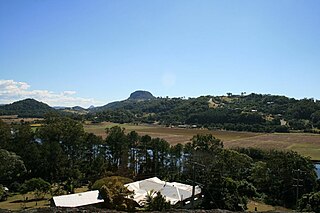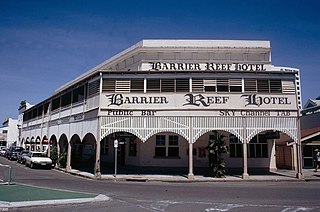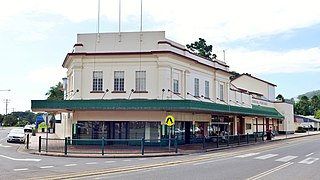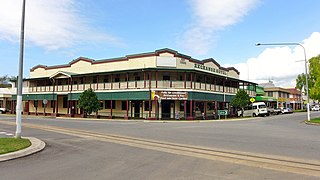
Port Douglas is a coastal town and locality in the Shire of Douglas, Queensland, Australia, approximately 60 km north of Cairns. In the 2021 census, Port Douglas had a population of 3,650 people. The town's population can often double, however, with the influx of tourists during the peak tourism season from May to September. The town is named in honour of a former Premier of Queensland, John Douglas. Port Douglas developed quickly based on the mining industry. Other parts of the area were established with timber cutting in the area surrounding the Daintree River and with settlement starting on lots around the Mossman River by 1880.

The Finger Wharf is a heritage-listed former wharf and passenger terminal and now marina, residential apartments, hotel and restaurant located at 6 Cowper Wharf Road, in the inner city Sydney suburb of Woolloomooloo, Australia. It was designed by Henry D. Walsh and built from 1910 to 1915 by the Sydney Harbour Trust. It is also known as Woolloomooloo Finger Wharf and Woolloomooloo Wharf. The property is owned by Transport for NSW. The structure is the longest timbered-piled wharf in the world.

Howard Smith Wharves is a heritage-listed wharf on the Brisbane River at Boundary Street, Brisbane City and Fortitude Valley, City of Brisbane, Queensland, Australia. It was built from c. 1934 to 1940s circa. It is also known as Brisbane Central Wharves. The 3.5-hectare (8.6-acre) site is one of the most culturally and historically significant riverfront locations in Brisbane. It was added to the Queensland Heritage Register on 4 February 1997.

William Street retaining wall is a heritage-listed embankment at William Street, Brisbane City, City of Brisbane, Queensland, Australia. It was built from 1889 to 1970s. It is also known as William Street & Queens Wharf Road retaining walls and North Quay porphry wall. It was added to the Queensland Heritage Register on 21 October 1992.
Ipswich Town Wharves are heritage-listed remnants of wharves beside the Bremer River at Bremer Street, North Ipswich, City of Ipswich, Queensland, Australia. They were built from 1847 to c. 1927. They were also known as Australasian Steam Navigation Wharf and William Collins and Son Wharf, J & G Harris Wharf, and Walter Gray and Co Wharf. They were added to the Queensland Heritage Register on 31 July 2006.

Dunethin Rock is a heritage-listed park at Dunethin Rock Road, Maroochy River, Sunshine Coast Region, Queensland, Australia. It was added to the Queensland Heritage Register on 5 February 2009.

Gin Gin railway station is a heritage-listed railway station at Mulgrave Street, Gin Gin, Bundaberg Region, Queensland, Australia. It was built from 1888 to c. 1928. It is also known as Gin Gin Railway Station, Goods Shed & Refreshment Rooms. It was added to the Queensland Heritage Register on 28 July 2000.

McCowat's Farm is a heritage-listed plantation at McCowat Road, Garradunga, Cassowary Coast Region, Queensland, Australia. It was built in 1920 by William Purdy. It is also known as Koodla. It was added to the Queensland Heritage Register on 21 October 1992.

St Saviour's Anglican Church is a heritage-listed former church building at 26 Hynes Street, South Johnstone, Cassowary Coast Region, Queensland, Australia. It was built from 1938 to 1939 by Mose Romano. It was added to the Queensland Heritage Register on 24 September 2004.

St David's Anglican Church is a heritage-listed church at 3 Foxton Avenue, Mossman, Shire of Douglas, Queensland, Australia. It was designed by Edward Taffs and Edwin Roy Orchard. It was added to the Queensland Heritage Register on 6 August 2010.

WWII RAN Fuel Installation is a heritage-listed former fuel depot and now arts centre at Collins Avenue, Edge Hill, Cairns, Cairns Region, Queensland, Australia. It was built in 1943. It was added to the Queensland Heritage Register on 2 February 2007.

The Cairns-to-Kuranda Railway is a heritage-listed railway line from the Cairns Region to the Shire of Mareeba, both in Queensland, Australia. It commences at Redlynch, a suburb of Cairns and travels up the Great Dividing Range to Kuranda within the Shire of Mareeba on the Atherton Tableland. It was built from 1913 to 1915 by Queensland Railways. Components of it include Stoney Creek Bridge, the Rail Bridge over Christmas Creek, Kuranda railway station, and Surprise Creek Rail Bridge. It was added to the Queensland Heritage Register on 21 August 1992. The railway is used to operate a tourist rail service, the Kuranda Scenic Railway. It forms part of the Tablelands railway line.

Cairns City Council Chambers is a heritage-listed former town hall and now council library at 151 Abbott Street, Cairns City, Cairns, Cairns Region, Queensland, Australia. It was designed by Hill & Taylor and built from 1929 to 1930 by Alex McKenzie. It was added to the Queensland Heritage Register on 5 October 1998. It is now home to the Cairns City Library.

Barrier Reef Hotel is a heritage-listed hotel at Abbott Street, Cairns City, Cairns, Cairns Region, Queensland, Australia. It was designed by Lawrence and Lordan in conjunction with Richard Hill built in 1926 by Carl Peter Jorgensen. It was also known as Empire Hotel. It was added to the Queensland Heritage Register on 29 July 1997.

Mulgrave Shire Council Chambers is a heritage-listed former town hall at 51 The Esplanade, Cairns City, Cairns, Cairns Region, Queensland, Australia. It was designed by Charles Dalton Lynch & Walter Hunt and built from 1912 to 1913 by Wilson & Baillie. It is also known as Cairns Shire Offices. It was added to the Queensland Heritage Register on 6 January 1999.

Cairns Wharf Complex is a heritage-listed wharf at Wharf Street, Cairns City, Cairns, Cairns Region, Queensland, Australia. It was built from 1910 to 1948. It was added to the Queensland Heritage Register on 17 December 1999.

St Mary's by the Sea is a heritage-listed non-denominational church at Wharf Street, Port Douglas, Shire of Douglas, Queensland, Australia. It was built from 1913 to 1914. It is also known as the former St Mary's Roman Catholic Church. It was added to the Queensland Heritage Register on 21 October 1992.

Mossman Shire Hall and Douglas Shire Council Chambers is a heritage-listed former town hall at 8-14 Mill Street, Mossman, Shire of Douglas, Queensland, Australia. It was designed by Hill & Taylor and built in 1937 by Tarmey & Euhus. It was added to the Queensland Heritage Register on 6 August 2010.

National Bank of Australasia Building is a heritage-listed former bank at 11 Mill Street, Mossman, Shire of Douglas, Queensland, Australia. It was designed by Lange Leopold Powell and built from 1935 to 1936 by Arthur E Zillfleisch and Tom Booth. It was added to the Queensland Heritage Register on 6 August 2010.

Exchange Hotel is a heritage-listed hotel at 2 Front Street, Mossman, Shire of Douglas, Queensland, Australia. It was designed by Vibert McKirdy Brown and built from 1934 to 1935. It was also known as Daintree Inn. It was added to the Queensland Heritage Register on 9 November 2012.























